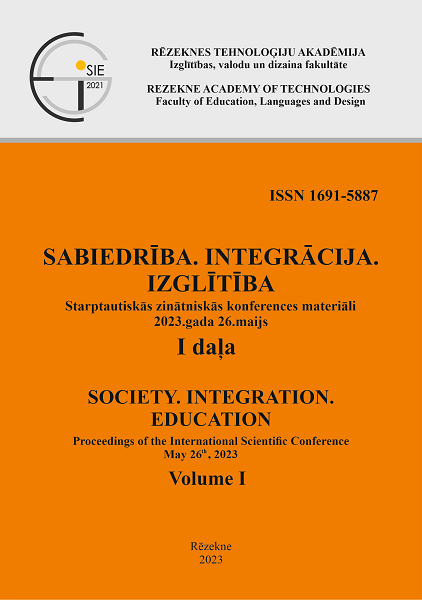EXPLORING EU STUDENTS’ BELIEFS AND EXPOSURE TO SEXUAL HARASSMENT AND SEXUAL ASSAULT
DOI:
https://doi.org/10.17770/sie2023vol1.7115Keywords:
employment, European Union countries, mean, ranking, sexual assault, sexual harassment, studentsAbstract
Sexual harassment and assault are the factors that decrease youth quality employment. The research aim is to explore students’ beliefs and exposure to sexual harassment and sexual assault in selected countries of the European Union underpinning the elaboration of implications for higher education. Theoretical analysis and modelling were used. The exploratory study was implemented to investigate the relationship between students’ self-assessment of their beliefs and levels of exposure in relation to sexual harassment and sexual assault in the selected countries of the European Union. The theoretical analysis resulted in the establishment of the inter-connections between sexual harassment and sexual assault, on the one side, and students’ employment and work/job, health as well as non-direct economic impact, on the other side. The exploratory study revealed that the level of students’ belief is higher if compared to the level of exposure to sexual harassment and assault. Students most believe that people physical appearance, race and being young impact sexual harassment and sexual assault. Exposure to sexual harassment and sexual assault coincide in relation witnessed sexual harassment and sexual witnessed assault as well as their ranking. Implications for higher education refer to teaching staff in higher education. Further research directions were proposed.
References
Ahrens, A., & Zascerinska, J. (2020). Comparison of Teacher’s and Students’ Ranking of English for Academic Purposes Sub-Topics. Education. Innovation. Diversity, 1(1), 16-25. DOI: http://dx.doi.org/10.17770/eid2020.1.5328
Ahrens, A., & Zaščerinska, J. (2015). Principles of Sampling in Educational Research in Higher Education. Proceedings of the International Scientifical Conference Society. Integration. Education. Volume 1 Higher Education Pedagogy, May, 22nd-23rd, 2015, pp. 25-35. – Rēzekne: Rēzeknes Augstskolas Izdevniecība, 2015. p 468.
Ahrens, A., Zascerinska, J., & Macovei, I. (2022a). EU Youth Beliefs in Gender Based Discrimination, Sexual Harassment and Sexual Assault. Education. Innovation. Diversity, 2(5), 47-57. DOI: https://doi.org/10.17770/eid2022.2.6963
Ahrens, A., Zascerinska, J., & Macovei, I. (2022b). A comparative study of youth gender based discrimination in employment in selected EU countries. International scientific conference “Societal Interactions: Rethinking Modern Issues” organised by SMK University of Applied Social Sciences, Vilnius, Lithuania, online. 17 November 2022.
Ali, M. S., & Jalal, H. (2018). Higher Education as a Predictor of Employment: The World of Work Perspective. Bulletin of Education and Research August 2018, Vol. 40, No. 2 pp. 79-90.
Banvard-Fox, C., Linger, M., Paulson, D.J., Cottrell, L., & Davidov, D.M. (2020). Sexual Assault in Adolescents. Prim. Care: Clin. Off. Pr. 2020, 47, 331–349.
Bon, H. D., Binh, N. V., Thanh, L. X., Quang, L. D., Ngan, H. T. K., Minh, N. T. T., Huyen, M. T. D., Hoang, N., Van, N. T., & Nhuan, N. T. (2015). Code of Conduct on Sexual Harassment in the Workplace. Retrieved from: https://www.ilo.org/wcmsp5/groups/public/---asia/---ro-bangkok/---ilo-hanoi/documents/publication/wcms_421220.pdf
Coe, R. (2010). Analysing ranking and rating data from participatory on-farm trials. African Statistics Journal, 10, 14-53.
Elbow, P. (1994). Ranking, Evaluating, Liking: Sorting Out Three Forms of Judgment. College English. 12. Retrieved from: https://scholarworks.umass.edu/eng_faculty_pubs/12
European Commission (EC). (2018). EU Youth Strategy. Retrieved from: https://europa.eu/youth/strategy_en
European Foundation for the Improvement of Living and Working Conditions. (2002). Quality of work and employment in Europe Issues and challenges. Foundation Paper Nr.1. February 2002. Retrieved from: https://edz.bib.uni-mannheim.de/edz/pdf/ef/fp/ef0212en.pdf
Exner-Cortens, D., Eckenrode, J., & Rothman, E. (2013). Longitudinal Associations Between Teen Dating Violence Victimization and Adverse Health Outcomes. Pediatrics 2013, 131, 71–78.
Kaltiala-Heino, R., Fröjd, S., & Marttunen, M. (2016). Sexual Harassment Victimization in Adolescence: Associations with Family Background. Child Abus. Negl. 2016, 56, 11–19.
Lim, S. C., Ghani, F. & Remme, M. (2018). Policy brief: Sexual Harassment: A Global Problem. United Nations University, International Institute for Global Health, Kuala Lumpur (Malaysia). Retrieved from: http://collections.unu.edu/eserv/UNU:7881/n2019-11-22_PB_SH_A_Global_Problem.pdf
Marginson, S., & van der Wende, M. (2007). To Rank or To Be Ranked: The Impact of Global Rankings in Higher Education. Journal of Studies in International Education, Vol. 11, No. 3/4, 306-329. DOI: http://dx.doi.org/10.1177/1028315307303544
Norcott, C., Keenan, K., Wroblewski, K., Hipwell, A., & Stepp, S. (2021). The Impact of Adolescent Sexual Harassment Experiences in Predicting Sexual Risk-Taking in YoungWomen. J. Interpers. Violence 2021, 36, NP8961–NP8973.
Raday, F., & Oksenberg, S. (2014). ‘The Impact of Violence against Women on Women’s Economic and Social Life’, Background paper for the Working Group on the issue of discrimination against women in law and in practice to inform the thematic report on ‘Discrimination against women in economic and social life, with a focus on economic crisis’, A/HRC/26/39, Human Rights Council 26th Session, 1 April 2014.
Sakellari, E., Berglund, M., Santala, E., Bacatum, C. M. J., Sousa, J. E. X .F., Aarnio, H., Kubiliut˙e, L., Prapas, C., & Lagiou, A. (2022). The Perceptions of Sexual Harassment among Adolescents of Four European Countries. Children 2022, 9, 1551.
Ståhl, S., & Dennhag, I. (2021). Online and Offline Sexual Harassment Associations of Anxiety and Depression in an Adolescent Sample. Nord. J. Psychiatry 2021, 75, 330–335.
Williams, L.M., & Walfield, S. (2016). Rape and Sexual Assault, Editor(s): Howard S. Friedman, Encyclopedia of Mental Health (Second Edition), Academic Press, 2016, Pages 13-22.






